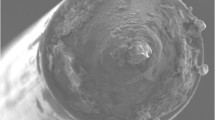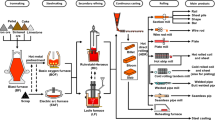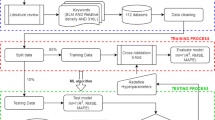Abstract
Steel-making process is a complex procedure involving the presence of exogenous materials which could potentially lead to non-metallic inclusions. Determining the abundance of inclusions in the earliest stage possible may help to reduce costs and avoid further post-processing manufacturing steps to alleviate undesired effects. This paper presents a data analysis and machine learning approach to analyze data related to austenitic stainless steel (Type 304L) in order to develop a decision-support tool helping to minimize the inclusion content present in the final product. Several machine learning models (generalized linear models with regularization, random forest, artificial neural networks and support vector machines) were tested in this analysis. Moreover, two different outcomes were analyzed (average and maximum abundance of inclusions per steel cast) and two different settings were considered within the analysis based on the input features used to train the models (full set of features and more relevant ones). The results showed that the average abundance of inclusions can be predicted more accurately than the maximum abundance of inclusions using linear models and the reduced set of features. A list of the more relevant features linked to the abundance of inclusions based on the data and models used in this study is additionally provided.
Access this chapter
Tax calculation will be finalised at checkout
Purchases are for personal use only
Similar content being viewed by others
References
Atzori, L., Iera, A., Morabito, G.: The internet of things: a survey. Comput. Netw. 54(15), 2787–2805 (2010). https://dx.doi.org/10.1016/j.comnet.2010.05.010
Breiman, L.: Random forests. Mach. Learn. 45(1), 5–32 (2001). https://doi.org/10.1023/A:1010933404324
Chapman, P., Clinton, J., Khabaza, T., Reinartz, T., Rüdiger, W.: The CRISP-DM process model. CRISP-DM discussion paper (1999)
European Commission: Factories for the future (2016). http://ec.europa.eu/research/industrial_technologies/factories-of-the-future_en.html
Hansson, K., Yella, S., Dougherty, M., Fleyeh, H.: Machine learning algorithms in heavy process manufacturing. Am. J. Intell. Syst. 6(1), 1–13 (2016)
Hassabis, D., Kumaran, D., Summerfield, C., Botvinick, M.: Neuroscience-inspired artificial intelligence. Neuron 95(2), 245–258 (2017). http://www.sciencedirect.com/science/article/pii/S0896627317305093
Kohavi, R.: A study of cross-validation and bootstrap for accuracy estimation and model selection. In: Proceedings of the 14th International Joint Conference on Artificial Intelligence IJCAI 1995, vol. 2, pp. 1137–1143 (1995)
Liao, Y., Deschamps, F., de Freitas Rocha Loures, E., Ramos, L.F.P.: Past, present and future of industry 4.0 - a systematic literature review and research agenda proposal. Int. J. Prod. Res. 55(12), 3609–3629 (2017)
Louppe, G., Wehenkel, L., Sutera, A., Geurts, P.: Understanding variable importances in forests of randomized trees. In: Advances in Neural Information Processing Systems, vol. 26, pp. 431–439 (2013)
Park, J.H., Kang, Y.: Inclusions in stainless steels - a review. Steel Res. Int. 88(12), 1700130 (2017)
Pham, D.T., Afify, A.A.: Machine-learning techniques and their applications in manufacturing. Proc. Inst. Mech. Eng. Part B: J. Eng. Manufact. 219(5), 395–412 (2005)
Rossi, F., Villa, N.: Support vector machine for functional data classification. Neurocomputing 69(7), 730–742 (2006)
Saravanan, M., Devaraju, A., Venkateshwaran, N., Krishnakumari, A., Saarvesh, J.: A review on recent progress in coatings on AISI austenitic stainless steel. Mater. Today: Proc. 5(6), 14392–14396 (2018). http://www.sciencedirect.com/science/article/pii/S221478531830600X. International Conference on Advanced Functional Materials 2017 (ICAFM 2017), Part 2
da Costa e Silva, A.L.V.: Non-metallic inclusions in steels - origin and control. J. Mater. Res. Technol. 7(3), 283–299 (2018). http://www.sciencedirect.com/science/article/pii/S2238785418300280
Susto, G.A., Schirru, A., Pampuri, S., McLoone, S., Beghi, A.: Machine learning for predictive maintenance: a multiple classifier approach. IEEE Trans. Ind. Inform. 11(3), 812–820 (2015)
Wuest, T., Irgens, C., Thoben, K.D.: An approach to monitoring quality in manufacturing using supervised machine learning on product state data. J. Intell. Manufact. 25(5), 1167–1180 (2014)
Wuest, T., Weimer, D., Irgens, C., Thoben, K.D.: Machine learning in manufacturing: advantages, challenges, and applications. Prod. Manufact. Res. 4(1), 23–45 (2016)
Zhang, L., Thomas, B., Wang, X., Cai, K.: A comparison of forecasting methods for RO-RO traffic: a case study in the strait of gibraltar. In: 85th Steelmaking Conference. Steelmaking Conference, Warrendale, PA (2002)
Acknowledgments
This work is part of the ACERINOX EUROPA S.A.U research project AUSINOX IDI-20170081 - “Obtaining austenitic stainless steels with minimum inclusion content from the development of new advanced simulation models in melting shop processes”, supported by CDTI (Centro para el Desarrollo Tecnológico Industrial), Spain. This project has been co-financed by the European Regional Development Fund (FEDER), within the Intelligent Growth Operational Program 2014–2020, with the aim of promoting research, technological development and innovation. Authors acknowledge support through grant RTI2018-098160-B-I00 from MINECO-SPAIN which include FEDER funds.
Author information
Authors and Affiliations
Corresponding author
Editor information
Editors and Affiliations
Rights and permissions
Copyright information
© 2019 Springer Nature Switzerland AG
About this paper
Cite this paper
Mesa, H. et al. (2019). A Machine Learning Approach to Determine Abundance of Inclusions in Stainless Steel. In: Pérez García, H., Sánchez González, L., Castejón Limas, M., Quintián Pardo, H., Corchado Rodríguez, E. (eds) Hybrid Artificial Intelligent Systems. HAIS 2019. Lecture Notes in Computer Science(), vol 11734. Springer, Cham. https://doi.org/10.1007/978-3-030-29859-3_43
Download citation
DOI: https://doi.org/10.1007/978-3-030-29859-3_43
Published:
Publisher Name: Springer, Cham
Print ISBN: 978-3-030-29858-6
Online ISBN: 978-3-030-29859-3
eBook Packages: Computer ScienceComputer Science (R0)




